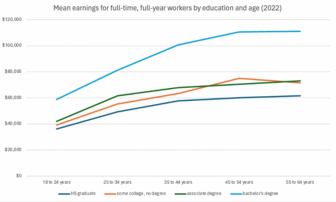For years we have used the following quote from Rich Karlgaard, publisher of Forbes magazine, to describe what increasingly drives state and local economic growth: “Best place to make a future Forbes 400 fortune? Start with this proposition: The most valuable natural resource in the 21st century is brains. Smart people tend to be mobile. Watch where they go! Because where they go, robust economic activity will follow.”
Karlgaard understood years ago what many still don’t today, that increasingly employers are following talent, rather than people moving to where the jobs are. In many ways this is the central insight of Richard Florida’s influential book The Rise of the Creative Class. That talent––primarily those with four year degrees or more––is the asset that matters most to knowledge-based employers.
Increasingly where talent is concentrated––particularly college educated Millennials––are central cities of big metropolitan areas. So it shouldn’t be a surprise that recently GE announced the relocation of its corporate headquarters from suburban Connecticut to Boston. And several months ago ConAgra announced the relocation of its corporate headquarters from Omaha to Chicago. These are just two examples of a larger trend of companies locating in vibrant central cities where young talent is concentrated. (Think Quicken to downtown Detroit.) Both GE and ConAgra cited access to talent as a major factor in their relocation.
In a Minneapolis Star Tribune article entitled ConAgra’s Move from Omaha to Chicago Shows Big Cities Still Reign Lee Shafer writes:
To a lot of us, big cities like Chicago primarily look expensive and crowded. But it’s long been observed by economists that productivity improves in cities. One reason is that good ideas and know how seem to leak between people who share the same place, even if they work for competitors.
Companies can thrive in places like that, in turn attracting engineers, marketers and other highly skilled people. It certainly helps attract them if the region also has a lot of sports, arts, outdoors and other amenities to make the hours after work more pleasant.
All of that means that in this case Chicago, a big metro area in a state so dysfunctional that its legislature and governor still can’t agree on a budget, gets another Fortune 500 company headquarters to add to the 31 already there.
Exactly! Talent trumps a lot of what conventional wisdom claims are the keys to retaining and attracting jobs––particularly high paid professional and managerial jobs. Things like taxes, regulation, well run state and local government, etc.
Former New York city mayor Michael Bloomberg in a Financial Times column summed up best what matters most to retaining and attracting employers this way:
Many newly successful cities on the global stage – such as Shenzhen and Dubai – have sought to make themselves attractive to businesses based on price and infrastructure subsidies. Those competitive advantages can work in the short term, but they tend to be transitory. For cities to have sustained success, they must compete for the grand prize: intellectual capital and talent.
I have long believed that talent attracts capital far more effectively and consistently than capital attracts talent. The most creative individuals want to live in places that protect personal freedoms, prize diversity and offer an abundance of cultural opportunities. A city that wants to attract creators must offer a fertile breeding ground for new ideas and innovations.
In this respect, part of what sets cities such as New York and London apart cannot be captured by rankings. Recent college graduates are flocking to Brooklyn not merely because of employment opportunities, but because it is where some of the most exciting things in the world are happening–in music, art, design, food, shops, technology and green industry. Economists may not say it this way but the truth of the matter is: being cool counts. When people can find inspiration in a community that also offers great parks, safe streets and extensive mass transit, they vote with their feet.






